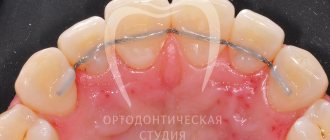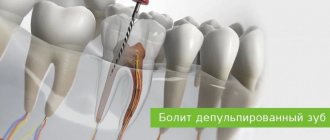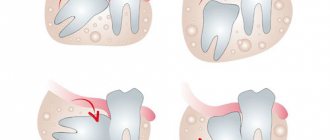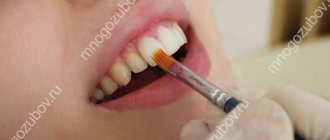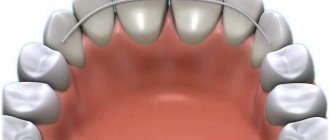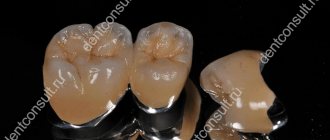28.11.2019
At the moment when the doctor informed the patient that the treatment process is over and that the braces system can be removed, teeth whitening after removing the braces becomes the most significant and important aspect for the client of the dental clinic. This is explained simply, because having received the desired result in the form of an even and beautiful row of teeth, the patient often faces unpleasant side effects in the form of stains on the tooth enamel. To get rid of such troubles, it is necessary to perform whitening so that no plaque or tartar remains on the teeth.
Is it possible to whiten teeth after braces?
It is not difficult to understand a patient who, after removing braces, suddenly discovers spots of different colors on his teeth; his desire to whiten looks quite natural. Of course, you can whiten your teeth after removing braces, but you will have to wait a little, about a month, before starting this procedure. By the way, there are also situations when a specialist recommends increasing the waiting period due to the individual characteristics of the patient’s oral cavity and the poor condition of his teeth. Whitening is based on a chemical reaction, as a result of which the released active oxygen penetrates the upper layers of the teeth and brightens them. Such an intervention is stressful, hence some pain experienced by the patient after its completion.
In any case, there is no need to rush, even if the appearance of the jaw is so smooth and beautiful because of its color. There are two important aspects that support this statement:
- during the waiting period, the enamel will be restored and will no longer be depleted and weak;
- the natural color of some areas can be restored without external aggressive intervention.
How to do whitening?
The teeth whitening procedure is one of the most effective and highly popular among dental patients. Its rather high cost is not the most pleasant moment, but the result obtained justifies all financial investments and costs.
When contacting a dentist with a similar problem, you can count on the following methods to solve the problem:
- hygienic cleaning with the help of which removes plaque and tartar, and also restores the natural color of the enamel;
- laser cleaning, which requires perfect cleanliness but gives excellent results;
- the use of special whitening strips that remove the yellow color of teeth and return them to their natural color.
Advantages and disadvantages of whitening
The key advantage of the whitening procedure is manifested in a person’s beautiful snow-white smile. In addition, yellow teeth are not only not very beautiful, but also not very stable, and this is not only a problem with the appearance of the teeth. Whitening makes it possible to get rid of plaque and tartar, prevents the growth of bacteria in the oral cavity, and accordingly the risk of developing caries is reduced.
However, whitening also has disadvantages, in particular the likelihood of certain complications, which are not difficult to avoid; it is necessary to visit the dentist in a timely manner to diagnose the condition of the enamel.
air flow
It is important to understand that you should start doing professional oral cleaning before installing orthodontic systems. As a rule, this is a prerequisite before starting treatment. In this case, any method of cleansing is suitable, since they all allow you to cope with hard deposits and small particles of food in the interdental spaces.
The Air Flow procedure is painless and cannot damage the structure of even the most fragile braces, so its use is approved by all dentists and orthodontists. Cleaning should be done when a large accumulation of plaque is detected, as well as to prevent its occurrence. However, even when using such technology, there are a number of nuances that should be taken into account.
Usually the doctor works with a regular aqueous solution, which is applied to the surface of the enamel under strong pressure. This jet instantly removes deposits and massages the gums well, improving blood circulation. The result after the procedure lasts for a long time.
Why is there a need for teeth whitening?
A very common unpleasant surprise for patients who have undergone treatment with braces, which is not possible to predict in advance, is a change in color in areas of the enamel not covered by the system. The most likely cause of such unattractive stains is eating foods with dyes, smoking and insufficient attention to oral hygiene. The bracket system serves as reliable protection against darkening, but after its removal, a real color imbalance is observed, which has to be restored with the help of bleaching.
Pastas for every day
These are pastes that clean well, strengthen and have a moderate antibacterial effect. They do not contain chlorhexidine or similar components and can be used every day.
Toothpaste ROCS PRO Brackets & Ortho
PresiDENT PROFI ORTHO BRACES toothpaste for braces
Philips Sonicare BreathRX toothpaste
Biorepair PLUS Total Protection toothpaste
Three ways to solve the problem
The problem of darkened enamel can cause serious inconvenience not only after removing the structure, but also during its wearing. In this case, the option of removing the system and performing teeth whitening is acceptable, but this is only permissible in a frankly advanced case, as well as if the patient has very decent funds, because you will have to pay for the additional work of a specialist. In all other situations, there are two other ways: teeth whitening after removing braces professionally or at home.
All about braces care
- How to care for braces after installation?
- Minimum contents of a braces care kit
- Basic rules for caring for teeth with braces
- What braces care products do orthodontists recommend using?
- Orthodontic wax and irrigator: additional elements of the standard set
- Features of caring for sapphire braces
The procedure for straightening teeth and correcting bite is considered one of the longest and most difficult in dental practice. The bracket system is quite expensive, and without regular maintenance it will require replacement before the end of its intended service life. That is why it is necessary to strictly adhere to hygiene rules and do not forget to clean your braces daily.
Of course, there is always a risk of physical damage to an expensive structure due to an impact, but much more often the consumption of “forbidden” food leads to deformation. Any sticky or hard foods should be completely excluded from the diet. Taffy, caramel and chewing gum are especially dangerous. Tiny particles can get behind structural elements and begin to attract the remains of other food. Over time, plaque forms behind the ligatures.
Features of teeth whitening after orthodontic treatment
There are many different methods that can successfully answer the question of how to whiten teeth, but not all of them are suitable for a patient who has just finished wearing braces. That is why it is so important to carry out this procedure only with the help of a specialist, using exclusively professional techniques. Each person has his own individual characteristics of the mucous membrane and enamel; accordingly, the selection of the necessary whitening gel, its composition and the concentration of the necessary substances in it must be carried out by a specialist. If this aspect is ignored, then the lack of the expected result will be less of a nuisance, but it will be much worse if serious damage is caused to the enamel.
Note: It should be understood that for teeth, especially if they have been damaged or weakened after installing and removing the braces, whitening is a serious stress.
Therefore, teeth whitening after removing braces should be performed no earlier than a month after their removal, so that the enamel has time to strengthen and the teeth to adapt to the new shape. True, whitening is not required in all situations; it happens that it will be quite enough to remove plaque without resorting to more radical solutions.
Summarizing all of the above, we can formulate three key rules for teeth whitening after the braces are removed:
- Use only professional techniques.
- You can start whitening after removing the system after a month.
- It does not always make sense to perform whitening; after consultation with a doctor, you can limit yourself to professional teeth cleaning.
Is it necessary to carry out hygienic cleaning before installing braces?
If there is evidence for this, then it is necessary, since braces must be installed on clean enamel. It is important that there is no accumulation of plaque underneath them, otherwise caries may develop under the braces. In addition, if there is a lot of plaque, it will be difficult to remove it with braces - it is better to do this before the system is fixed.
However, if you have recently had dental hygiene, it is better to postpone the procedure a little and go through it 2-3 months after installing the braces system - it will be much more effective.
Types of teeth whitening after removing braces
Existing teeth whitening techniques can rightfully be called unique and specific, but they all have common features:
- The whitening procedure should be preceded by a diagnosis of the enamel and its condition, because if it is severely weakened, then chemical intervention will cause even more harm to it, accordingly, it will first need to be strengthened;
- in all cases, a key role is played by a special gel made taking into account the individual characteristics of the patient;
- the basis of the bleaching agent is made up of chemical elements such as hydrogen and carbonate peroxide, the concentration of which is approximately 20%;
- the whitening effect is achieved due to the release of active oxygen that penetrates the enamel as a result of a chemical reaction;
- Upon completion of whitening, it is necessary to perform procedures to strengthen the top layer of teeth.
The main difference between different bleaching methods will be in the methods of accelerating the reaction, which in turn directly affects the final result of the entire process.
Regular toothbrush
A regular brush, which is sold in any store, removes plaque on the outside and inside of the teeth.
Moving the brush in a circular or up-and-down motion can push plaque under the gum and cause inflammation.
If you brush your teeth with horizontal movements to the right and left, the interdental spaces are poorly cleaned and there is a high probability that the gingival surfaces of the teeth will remain uncleaned. The result is inflammation of the interdental papillae and caries on the contact surfaces of the teeth.
How to brush your teeth correctly? It is necessary to hold the brush horizontally and, using sweeping movements from the gums to the cutting edge, clean off plaque from the outside of the dentition of both jaws. Then, placing the brush vertically, brush the inside of the teeth, also from the gums to the cutting edge. Then brush the chewing surfaces of your teeth as usual. At least 10 cleaning movements should be performed on each surface of each tooth.
Preparing for whitening in the clinic - teeth cleaning
When the orthodontist has completed the procedure for removing braces, he then proceeds to the procedure of professional teeth cleaning, which involves the following operations:
- Elimination of glue residues from enamel. It is a well-known fact that the clasps of the braces structure are attached to the teeth using an adhesive base. Some of this substance remains on the enamel after removing the system, therefore, it must be completely removed.
- The procedure for removing plaque and tartar, without this it is not possible to perform whitening.
Let us assume the option of using special trainers, which in this case will be used with a bleaching composition.
Cleaning before braces: why is it needed?
Correction of the bite always begins with sanitation of the oral cavity. In addition to treating diseases of the teeth and gums, it includes mandatory professional cleaning before installing braces. The doctor will remove hard deposits with ultrasound, and soft deposits with a thin and powerful jet of cleaning powder solution (AirFlow technology). After this, the teeth will need to be polished with a special paste and coated with a fluoride-containing preparation to strengthen the enamel. Such a hygienic procedure should be carried out 3 - 5 days before installation, but no later than 24 hours.
What happens if you don’t brush your teeth before braces? Bacterial plaque will get under the elements of the system, in particular under the clasps that are glued to the enamel. Considering that orthodontic appliances are worn for a year at best, and two years on average, microorganisms will have enough time to multiply and lead to the formation of caries. It is impossible to properly cure it with braces on the teeth. There is a risk of early removal of the device, and this will spoil the final result, and the patient will waste money, time and moral strength. This is why brushing your teeth before getting braces is mandatory.
Be patient
Many patients, who are ready to amaze the world with their truly snow-white and dazzling smile after removing braces, almost panic when they see darkened spots on their teeth and immediately intend to carry out the whitening procedure. You should not rush; you will need to wait at least a month, or even more, for the tooth enamel to return to normal and recover after wearing braces. Moreover, it happens that after some time it returns to its usual appearance on its own and bleaching becomes an absolutely unnecessary operation. In addition, you should always remember that its action is based on a chemical reaction, which is aggressive in nature; you should weigh everything well and think it over before exposing your teeth to such effects.
Gentle method
This problem may have a simpler solution that does not require such radical measures, namely the most common hygienic action based on the use of AirFlow water-abrasive cleaning. Its use eliminates the negative impact on enamel, since it does not involve the use of aggressive chemicals. Many experts recommend performing this cleaning method first after removing the system, and if this option does not give the expected result, then after some time the issue of bleaching can be put on the agenda.
How to whiten teeth at home?
This may seem strange, but at home it is quite possible to get very good whitening results using the following techniques:
- the use of whitening gels, which give excellent and, very importantly, long-lasting results;
- the initial stage of tartar and plaque can be easily removed by regular brushing of the teeth and mouth, which should also include the use of dental floss and rinses;
- using herbal infusions, for example, sage leaves, which will have a beneficial effect on the condition of the gums.
Cleaning and whitening at home should be carried out with a high degree of accuracy and caution, because teeth have become more sensitive, and any aggressive impact can have the opposite effect on them than expected.
Lemon
The ascorbic acid contained in lemon is beneficial not only for human gums, but also for the entire body. As for whitening with lemon, there are many options for this procedure, the simplest of which involves using one slice of a simple lemon to treat the enamel. Let’s also say a method based on adding a few drops of lemon juice to the toothpaste, which, by the way, will also help with bleeding gums.
Such products should be used carefully, no more than once a week; those who have increased tooth sensitivity should be especially careful.
Category Hygiene Published by Mister stomatolog
Professional hygiene in the dentist's office
The hygienist, using professional Air-Flow products and an ultrasonic nozzle, will completely clean the teeth of plaque and stones (if they appear), perform deep fluoridation of the teeth to strengthen the enamel and conduct a preventive examination for the occurrence of caries or gum inflammation.
It is necessary to visit a hygienist at least once every six months, but more often. Orthodontists recommend undergoing professional hygiene and examination once every 3-4 months. If your attending orthodontist notices that you clean plaque well enough on your own, he will recommend having professional hygiene done once every 6 months.
